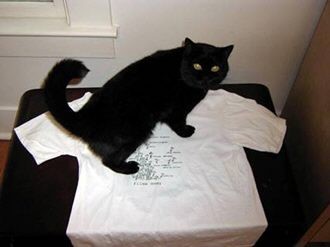| R-I-P Rascal, a very real cat. |
I never went back to the clinic to pick up the cat carrier. In every animal hospital there must be a secret mountain of discarded carrying cases, frayed leashes, and abandoned squeeze toys. Apparently, there are no pet toys in the happy hunting grounds.
I can’t remember which virtual world claimed most of my time that week. It might have been a three-dimensional space such as Second Life or World of Warcraft. Or it might have been a two-dimensional hodge-podge of online forums, emails, spreadsheets, and instant-messaging conversations. All I know is that I was more active in these online spaces than in my own home.
In material terms, my body was physically present the week before Rascal died. I showered, taught class, cleaned out the cat box, and took out the trash. From the point of view of my cats, I might as well have been a ghost. Organizing a conference on global virtual worlds, my attention was riveted to the computer screen. Technically, I experienced what virtual-world scholars refer to as “telepresence.” I was active and engaged in authentic human community, but my attention was elsewhere.
This is not a confession. I don’t blame myself for not spending more time with Rascal during the last week of her life. Well, not much. There was no way of knowing that she was going to die, and my energies were focused on a personally meaningful project.
Nor is this a seasonally appropriate sermon about paying attention to the Things That Truly Matter™. Ever since my childhood, self-righteous pundits have clogged the cultural airwaves with these pronouncements. Even at the age of 8, I remember thinking “Pay attention to the things that matter? Well, duh!” Such insights are about as profound as “Eat only the foods that are edible” and “Cover thy head when water falls from the sky.”
I was devastated by Rascal’s death, and my feelings of grief were not unique. Most of us have lost someone unexpectedly, and many know the feeling of regret that stems from not having the chance to say goodbye.
At the heart of all of such regrets, there is a common human currency: our capacity to pay attention and our ability to be truly present. This capacity for attentiveness is one of the vital gifts of the human condition. It is also the primary commodity of our global cultural economy.
Advertising and public relations revolve around the quest for attention. Ever wonder why over-the-air television and radio broadcasts are “free?” For that matter, why is this weekly newspaper free? The answer is that you are the product being bought and sold. Media owners are in the business of delivering human attention. It’s called “selling eyeballs.”
Digital media multiply the demands on our attention while privatizing our entertainment experience. Most new video games boast 60 to 80 hours of game-play. DVDs and personal video recorders (PVRs) enable new time-shifting behaviors that make it possible to catch up on an entire television series over the course of a few weeks. And virtual worlds such as Vanguard and Second Life encourage us to shift our attention to entirely new realms of fantasy and creation.
And then there are the immediate claims on our attention from those who love and live with us. Though we desperately crave attention, most of us lack a vocabulary for talking about it. And, even if we’re able to voice our desires, we don’t know how much attention one person can reasonably expect from another. We can only pay attention to so many things at once. There are no pithy answers to this constraint of human existence, and there is no technological solution. Attention-deficit drugs may help us focus, but they don’t expand our attention supply.
The only surefire way to increase our attention bandwidth is to sleep less, but our bodies stubbornly resist such efforts. At best, “wakefulness promoting agents” such as Modafinil can give us 20-25 additional hours of consciousness each week. These drugs are expensive and taboo, and we know little about their long-term effects.
A week after Rascal’s death, a car screeched to a stop in front of my house and the driver dashed up to my front porch. “Here’s Rascal,” he said as he thrust a cheap plastic urn into my hands. “Gotta run. More deliveries to make before the weekend.”
“This is not Rascal,” I thought.
She sits on the mantle in my living room. Technically, she’s physically present. But Rascal is dead. Energy. Soul. Consciousness. Presence. Attention. Whatever term you choose to use, her spark is gone. Just as she once pined for my playful attention, I now pine for hers.
















